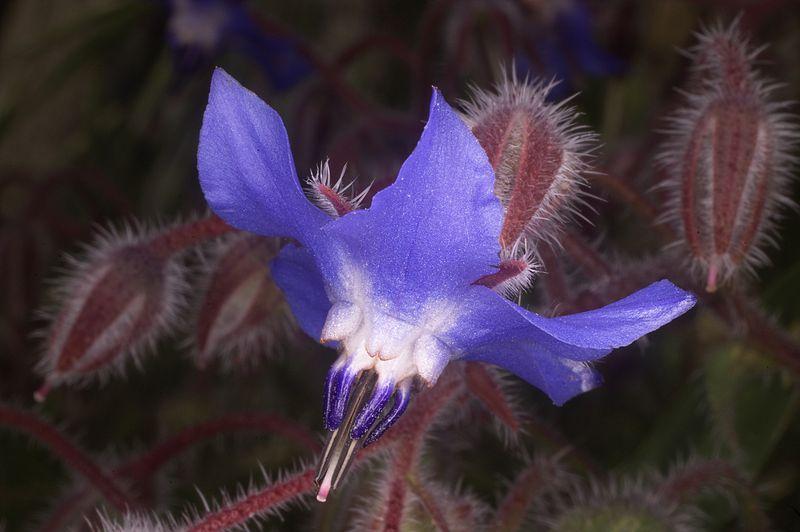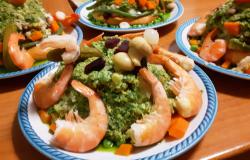Spring is the time to collect the wild edible plants nature gifts gardeners before laying seeds for summer gardens. In the steep hills of Liguria, a difficult but rewarding gardening environment, these gifts are numerous: bushy bietole (broccoli rabe) leaves, thin shoots of wild asparagus, and—my personal favourite—boraggine (borage).
Tall stalks or borage, heavy with star-shaped flowers, can be painful to gather due to the thick coat of needle-like spines on mature stems. The delicate blue, purple, or white flowers are lovely enough that the plant is sometimes used ornamentally, and their perfectly symmetrical five-pointed shape has earned the plant the nickname starflower. The flowers, stems, and leaves are all edible.

Ancient Medicinal Uses
In Ancient Greece and Rome, borage was regarded as a neurotoxin, adept at relieving depression. Ancient Greeks began adding it to wine, along with lemon and honey. Pliny called it euphrosinum because of its euphoric effects, and he and Dioscorides reported that Homer favoured it in his wine for its ability to bring absolute forgetfulness.
The plant’s name is widely believed by scholars to come from Arabic “abu rach”, meaning “father of sweat”, because of the plant’s ability to induce sweating, As sweating lowers body temperature, borage oil and borage leaf tea have been used for millennia to treat fever associated with colds, rheumatism, and other inflammatory conditions. Borage tea or steam is also used to treat pulmonary issues.
Culinary Origins
Cookbooks and medical texts from the seventeenth century mention the green stems and tougher mature leaves boiled as a pot-herb—an addition to soups and other long-cooking dishes—and raw borage leaves as a salad ingredient. Doctors during this period also prescribed the leaves to people who had been ill recently, to give them “good blood”. The young leaves, which hadn’t yet grown prickles, were valued for their refreshing, cucumber-like taste.
Because borage was more common in the nineteenth century than cucumbers, which originally come from India and were not widely cultivated in Europe until modern times, it was the original garnish for Pimms Cup, a British cocktail based on gin, spices and fresh fruit. It also featured prominently as a flavouring agent in certain gins.

Cooking Borage Greens
In the spring, stewed, steamed or sautéed borage takes the place of spinach in many Ligurian dishes. You can eat the greens simply on their own, boiled and quickly dunked in cold water—to preserve the colour—with a squeeze of lemon juice, salt, pepper, and fresh olive oil. They are also often prepared in this manner and chopped, or chopped and sautéed with garlic and olive oil, and added to frittatas and other egg dishes.
The herb’s most prominent, or even beloved, uses though, is as a pasta filling. On its own or mixed with chard and spinach, borage makes an ideal filling for square ravioli or triangular pansotti, a pasta named for its plumply-filled “belly” (pancia in Italian). Blanched and chopped, the stems, leaves, and even flowers if you wish, are mixed with Prescinseua, a slightly runny and acidic goats-milk cheese and stuffed into a durum wheat flour and egg pasta. In lieu of Prescinseua, substitute goats-milk ricotta, or even yogurt for the appropriate acidity.

How to Eat Borage Flowers
Borage flowers are one of the few edible blue plants. A non-toxic chemical imparts both the colour and a honey-like, sweet taste. Uncooked borage flowers add a colourful and faintly sweet accent to spring green salads, and also work, in combination with a few young leaves, as a garnish for meat courses.
Candied borage flowers, similar in look and function to candied violets, are used to decorate cakes. They go particularly well with citrus-flavoured cakes, creating a combination like a honeyed cucumber lemonade, and as an accent to Italian olive oil cakes. The candied flowers can also be turned into a preserve and spread on toast or breakfast biscuits.
Finding and Using Borage Outside Italy
Borage, like many other specialty greens, is appearing more and more frequently in farmers’ markets outside of Italy. Though it’s considered an herb, borage does not dry well. Use the leaves and stems within two days and the flowers within three to five.
You can also grow it yourself easily in temperate zones. It is hardy and flourishes in nearly any type of soil, but prefers full sunlight and does not fare well in windy areas. Grown inside in an area with ample sunlight, borage will continue to leaf all winter.








